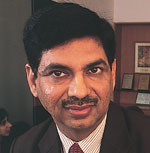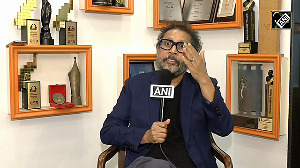In the pharmaceutical industry sales are completely determined by the drive of the sales force.
Rajiv Gulati, Chairman & Managing Director, Eli Lilly India Private Limited, shares how the company creates passion in its people by looking after their needs.
 If what is inside the vial is difficult to differentiate, one must look outside. A motivated sales force can create the difference between an average company and the leader, says Rajiv Gulati, Chairman and Managing Director of Eli Lilly India Private Limited.
If what is inside the vial is difficult to differentiate, one must look outside. A motivated sales force can create the difference between an average company and the leader, says Rajiv Gulati, Chairman and Managing Director of Eli Lilly India Private Limited.
For Gulati, prioritising the sales force goes way back to those early days when the company was formed. . .
It was the winter of 1992 when Andrew Mascarenhas, came over from Puerto Rico to become Managing Director of, what was then a joint venture between Eli Lilly of the United States and Ranbaxy of India. He was joined by Gulati, Director, Sales and Marketing.
On the first day both sat across a broken table in a small room, wondering how to start a company that was different. The only thing they agreed upon was that every bit of conventional wisdom should be challenged and examined before a decision was taken.
The first priority that emerged during the discussion was organisation culture and the slogan was, 'If you look after people, results will look after themselves.'
With this gameplan a new company was incorporated and it quickly achieved breakeven in a mere three years. Soon after that Gulati left for Indianapolis and a stint at the corporate headquarters of the parent company.
When he returned in 1999, it was to assume charge as chairman and managing director. Then by 2001 Eli Lilly and Company acquired Ranbaxy's 50% stake to create a 100% Lilly subsidiary in India under Gulati's leadership. Today sales at Eli Lilly India have increased from a modest Rs 80 million in 1994 to Rs 1.50 billion in 2003, and its 550-people strong sales force is among the most satisfied in the Indian pharmaceutical industry.
In this exclusive interview with The Smart Manager, Gulati reveals how they made this happen. . .
How do you prioritise the sales force at Eli Lilly?
Not only is more than 80% of our organisation based outside the headquarters, the sales performance of the company is the sum total of sales generated by each of these individuals. At Eli Lilly, the entire organisation is oriented towards providing the best support to its sales force, so that they in turn, are motivated to deliver the best to the customers.
This is crucial, because in the pharmaceutical business, sales force is the only medium of communication with the customers. The image and the performance of the company depends entirely on them. Thus, it is intuitive that the sales force be the center of universe, and all the staff functions do their best to support them.
This message has been shared many times within the entire organisation. For example, the finance function realises that it is important to ensure that sales people get their salary and expense reimbursement in time, so that hygiene factors are taken care of, and these do not distract the sales force from their prime objective.
At the same time, the HR function realises that providing development and career opportunities are important motivating factors. All the functions at HO are geared to enthuse, motivate and support the TMs (Territory Managers) so that they can do the greatest job possible. We also have programmes that identify the needs of the sales force in order to fulfill them.
Take us through the process you follow to identify the needs of the sales force. . .
Before we fulfill the needs of the sales force, we try to understand their needs first. We have designed two structured processes to collect this feedback. The first is called 'Health of the Organisation Survey'. This survey evaluates the support they receive from each function.
The results are shared with the entire organisation and issues are prioritised for focus. So far, the survey has been done twice, with a gap of one year in between. Over this period, we have seen significant improvement in service levels and in processes such as reimbursement of expenses, statement of accounts, inventory management, et cetera.
The second process is a forum called 'Open House'. To keep in touch with the grass root reality, I meet each and every employee of the organisation at least once in a year. This forum typically consists of homogeneous groups without supervision.
The conversations in these meetings are kept confidential and no names are mentioned. These two surveys provide a reality check and give important clues to help us to move constantly in the direction of becoming a people-centric organisation.
Can you share how you actually go about selecting new recruits for the sales force?
Having decided that the sales force is the prime differentiator in the market place it is but natural to try and recruit the brightest people and provide them with the best training possible. Here it becomes important not to follow the traditional practice and think laterally.
Traditionally, pharmaceutical companies have tended to employ male science graduates based on their performance in the interview. At Lilly each of these three things were challenged, with the result that Lilly was one of the first companies to recruit women in large numbers and the focus remained on intrinsic ability of the individuals regardless of their educational background.
Since a thirty-minute interview cannot give an insight into any individual's potential, Lilly India follows an intensive 'Nine-Step Recruitment Process' that is unique in India and the Lilly world.
These are group discussion, written test in English, reasoning and sales aptitude, preliminary review, open-ended medical representative assignment, final interview, psychological profiling, pre-IDP field work, medical test and IDP (Initial Development Programme).
This recruitment process takes lot of time and the success rate is one recruitment out of 120 applicants. Yet it is worth going through this as it is important to get people not only with the right aptitude but also with the right attitude.
Once a person is recruited, what happens then?
For the last eleven years of the company's existence, for all the 46 batches' that have been recruited, it has been a tradition that the first session is always taken by the managing director. This is the time the importance of 'values' is discussed and clear expectations are shared to preserve the culture of the organisation.
In addition, the trainees get a chance to interact with each of the functional heads. The training program, 'Initial Development Programme' (IDP), is a one-month residential programme, where even the trainers stay with the trainees. Where as the focus during this initial development programme is on science and selling, they return after three months for another one-week residential programme to see the relevance of the theory of selling skills to their real life experience.
Shared learning at this time improves their confidence level and reinforces their faith in their own ability. All the TMs come back again after eighteen months, for a programme called 'Trend Setters' where they learn how to be the role models. And finally, after 36 months they come back for yet another residential training programme called 'Mentors' where they learn to coach their less experienced colleagues.
In today's competitive world 'focus' is key to success and Lilly was one of the first organisation to create multiple teams with each specialised team focusing on a key therapeutic area. This structure sharpens the focus on customers, since each sales team, and each group of customers, are homogenous, with similar needs.
But how do you manage to retain talent?
All the HR processes for example, structure, compensation, performance evaluation etc, are geared towards this end. It was only one generation ago when people joined one organisation and retired from the same organisation.
Building a house, buying a car, educating ones children and getting them settled was all that one hoped to achieve by the end of one's career. In today's liberal economy, the aspirations are vastly different. Employees aspire for a quicker growth and want all the amenities at the beginning of the career. It is an interesting challenge to recruit, retain and motivate talented people in this scenario.
The old formula of providing cash incentives for excellent performance does not work any more. Today it is career, career and career. At Lilly, the path for career growth is transparent and easy to understand. Explaining the promotion process and providing a vision of what is possible is the first thing that is done to the new entrant.
The HR policies are no longer a black box. There are other interesting examples to create a congenial, people friendly environment. For example, when young graduates who have lived all their lives with their parents, go out to create a new life in a new city, they are received at the railway station by their team members.
Their supervisor helps them to find a place to live, helps to find a place to eat and helps them open a bank account. The 'care package' helps in creating a bond between employees and the supervisors. At HO there is a cultural committee to jazz up the life of the employees. There is a party for every occasion.

If sales force people are highly motivated like you say, then how do you provide for their career growth?
For the last years Lilly has assiduously practiced internal promotions and cross-functional rotations. Even though it is fraught with risk, this provides the best opportunity to the employees. Though this goal has remained constant, the process has undergone a change in the last 4 to 5 years.
Initially, whenever a position fell vacant, all the eligible employees were called for an interview and the decision was taken. It became apparent over a period of time that this process favored those with good communication skills and was detrimental to those with real skills and high potential, but with limited ability to impress with their vocabulary.
Hence, to accurately assess 'employees potential', and the 'readiness for promotion' to the next level; two committees call the Potential Assessment Committee (PAC) and Talent Assessment Committee (TAC) were created.
Tell us more about these committees. . .
PAC looks at the person's long term potential. It identifies people with high potential and gives them an accelerated career opportunity.
This committee looks at two aspects: the candidate's past performance and the individual's learning agility, which points towards his ability to learn quickly and work in unstructured situations.
The other committee, TAC, has a narrower focus. It looks simply at the current level of the person's skills and decides whether a person is 'promotion ready' today or not. Regardless of the decision, the key output of these processes is an objective evaluation of the employee's strengths and weaknesses.
This feedback is a foundation on which the development plan of the employee is built.
These are annual processes which help in creating a reservoir of talent from which candidates are picked and promoted as and when a position falls vacant. A significant aspect of these processes is that the ownership of the decision and the feedback is taken completely by the supervisor, since he/she is the one who presents the candidate to PAC and TAC.
Not everyone in the organisation is fit to become a general manager. People with high technical skills and excellent track record need a career too. An organisation needs indepth functional expertise to succeed in today's competitive world. This is the genesis of STAC (Specialty Talent Assessment Committee). As apparent, this is for those employees who specialise in a particular field and contribute immensely with the depth of their knowledge.
Apart from creating innovative approaches, we also borrow ideas from Lilly Global and other successful companies. One significant example of such customisation is the 'competency model.' The parent company had developed a competency model for market research and brand management. On one hand Lilly India implemented the marketing competency model with minor changes, on the other hand, a cross-functional team got together to create 'competency models' for all functions. Today, Lilly India is the only affiliate within Lilly world to have the Competency Model for each and every function and sub function.
But how do you manage to incorporate these processes through the organisation? Have you faced any resistance?
HR is everyone's job: Though Lilly has been associated with Hewitt since inception and with Mercer more recently, most of the HR processes have been home grown. These have been created by cross-functional teams bringing refreshing practicality to the policies and providing ownership. These teams have overhauled the entire performance assessment system.
Today, this process provides total clarity to each employee on what is expected from him/her. The feedback from the supervisor is given periodically. Since the priorities of 'key result areas' are clear between supervisor and subordinate, there is rarely a disagreement at the end of the year.
Rather, the entire process focuses on constant development, either indepth functional expertise, or towards softer skills required for supervision and leadership.
And the result is: The attrition rate is falling. Year after year, Lilly India has been topping the employees morale list in the Eli Lilly Global 'Voice of the Employees Surveys' Lilly, India was the top ranking pharmaceutical company in both, 'Great Places to Work', survey conducted by GPW Inc. USA and Business World, as well as 'Best Employer' survey con-ducted by Hewitt Associates and Business Today.
Most significantly Lilly India has constantly been one of the fastest growing pharmaceutical company in India. For example, in 2003 we grew by 25% against the industry growth of 7%.
The slogan that we started with, has become a reality. We have been looking after our people, and results have been looking after themselves.
Gita Piramal is the Managing Editor, The Smart Manager.
Published with the kind permission of The Smart Manager, India's first world class management magazine, available bi-monthly.







 © 2025
© 2025